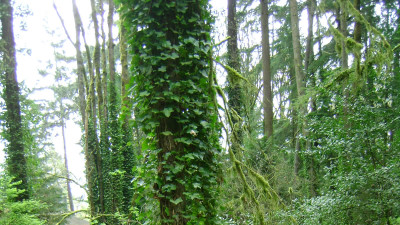 ENGLISH IVY (Hedera helix) grows as a vine and has waxy green leaves. The leaf is about the size of a child’s hand. When it climbs trees, it can produce viable seeds that birds ingest, and more plants come up in their poop. Ivy infested trees also tend to topple more easily in windstorms—there goes the electricity!
ENGLISH IVY (Hedera helix) grows as a vine and has waxy green leaves. The leaf is about the size of a child’s hand. When it climbs trees, it can produce viable seeds that birds ingest, and more plants come up in their poop. Ivy infested trees also tend to topple more easily in windstorms—there goes the electricity!
To tackle a tough ivy problem, treat it in stages:
- Release the trees: kill the ivy growing vertically on trees and stumps first. When ivy grows vertically at least 3 feet, it produces berries which are eaten by birds and spread. Tree ivy can also act as a wind sail to destabilize trees and make them more likely to fall over in a storm. Cut the ivy all the way around a tree at a height you can reach. Create an ivy-free zone on the trunk of at least a few feet to break the connections between ground and tree.
- Create a “circle of life”: clear ivy from the base of the trees in a circle at least 5 ft in diameter. This will give the tree, and you, some breathing room from the tree being re-invaded while you work on the problem.
- Clear ground ivy: Prioritize highly-infested areas. Work carefully and incrementally in steep slopes. Re-plant and monitor once ivy has been cleared from an area, so that other plants can establish and form cover that is more resistant to ivy.
- Be patient and persistent: Ivy can take many years and vigilance to clear. Re-establishing native vegetation and regular checks on re-infestations can ensure success! You and native wildlife and vegetation will all be very grateful for the hard work.
For more information about the ecology, impacts, and control of ivy, check out the King County page for English Ivy
